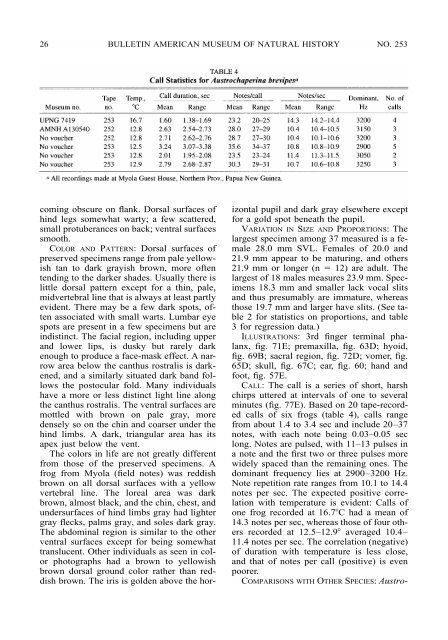SPHENOPHRYNE - American Museum of Natural History
SPHENOPHRYNE - American Museum of Natural History
SPHENOPHRYNE - American Museum of Natural History
Create successful ePaper yourself
Turn your PDF publications into a flip-book with our unique Google optimized e-Paper software.
26 BULLETIN AMERICAN MUSEUM OF NATURAL HISTORY NO. 253<br />
coming obscure on flank. Dorsal surfaces <strong>of</strong><br />
hind legs somewhat warty; a few scattered,<br />
small protuberances on back; ventral surfaces<br />
smooth.<br />
COLOR AND PATTERN: Dorsal surfaces <strong>of</strong><br />
preserved specimens range from pale yellowish<br />
tan to dark grayish brown, more <strong>of</strong>ten<br />
tending to the darker shades. Usually there is<br />
little dorsal pattern except for a thin, pale,<br />
midvertebral line that is always at least partly<br />
evident. There may be a few dark spots, <strong>of</strong>ten<br />
associated with small warts. Lumbar eye<br />
spots are present in a few specimens but are<br />
indistinct. The facial region, including upper<br />
and lower lips, is dusky but rarely dark<br />
enough to produce a face-mask effect. A narrow<br />
area below the canthus rostralis is darkened,<br />
and a similarly situated dark band follows<br />
the postocular fold. Many individuals<br />
have a more or less distinct light line along<br />
the canthus rostralis. The ventral surfaces are<br />
mottled with brown on pale gray, more<br />
densely so on the chin and coarser under the<br />
hind limbs. A dark, triangular area has its<br />
apex just below the vent.<br />
The colors in life are not greatly different<br />
from those <strong>of</strong> the preserved specimens. A<br />
frog from Myola (field notes) was reddish<br />
brown on all dorsal surfaces with a yellow<br />
vertebral line. The loreal area was dark<br />
brown, almost black, and the chin, chest, and<br />
undersurfaces <strong>of</strong> hind limbs gray had lighter<br />
gray flecks, palms gray, and soles dark gray.<br />
The abdominal region is similar to the other<br />
ventral surfaces except for being somewhat<br />
translucent. Other individuals as seen in color<br />
photographs had a brown to yellowish<br />
brown dorsal ground color rather than reddish<br />
brown. The iris is golden above the hor-<br />
izontal pupil and dark gray elsewhere except<br />
for a gold spot beneath the pupil.<br />
VARIATION IN SIZE AND PROPORTIONS: The<br />
largest specimen among 37 measured is a female<br />
28.0 mm SVL. Females <strong>of</strong> 20.0 and<br />
21.9 mm appear to be maturing, and others<br />
21.9 mm or longer (n 12) are adult. The<br />
largest <strong>of</strong> 18 males measures 23.9 mm. Specimens<br />
18.3 mm and smaller lack vocal slits<br />
and thus presumably are immature, whereas<br />
those 19.7 mm and larger have slits. (See table<br />
2 for statistics on proportions, and table<br />
3 for regression data.)<br />
ILLUSTRATIONS: 3rd finger terminal phalanx,<br />
fig. 71E; premaxilla, fig. 63D; hyoid,<br />
fig. 69B; sacral region, fig. 72D; vomer, fig.<br />
65D; skull, fig. 67C; ear, fig. 60; hand and<br />
foot, fig. 57E.<br />
CALL: The call is a series <strong>of</strong> short, harsh<br />
chirps uttered at intervals <strong>of</strong> one to several<br />
minutes (fig. 77E). Based on 20 tape-recorded<br />
calls <strong>of</strong> six frogs (table 4), calls range<br />
from about 1.4 to 3.4 sec and include 20–37<br />
notes, with each note being 0.03–0.05 sec<br />
long. Notes are pulsed, with 11–13 pulses in<br />
a note and the first two or three pulses more<br />
widely spaced than the remaining ones. The<br />
dominant frequency lies at 2900–3200 Hz.<br />
Note repetition rate ranges from 10.1 to 14.4<br />
notes per sec. The expected positive correlation<br />
with temperature is evident: Calls <strong>of</strong><br />
one frog recorded at 16.7C had a mean <strong>of</strong><br />
14.3 notes per sec, whereas those <strong>of</strong> four others<br />
recorded at 12.5–12.9 averaged 10.4–<br />
11.4 notes per sec. The correlation (negative)<br />
<strong>of</strong> duration with temperature is less close,<br />
and that <strong>of</strong> notes per call (positive) is even<br />
poorer.<br />
COMPARISONS WITH OTHER SPECIES: Austro-
















